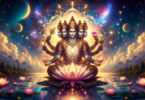By Mateo Sol
Guest writer for Wake Up World
“Become whole,” “Seek for wholeness,” “Experience more wholeness.”
What does this mean?
We’ve mentioned wholeness a lot on this website. And if you’re a spiritual seeker, soul searcher, or self-growth veteran, you would’ve heard this term a lot.
But what does it actually mean?
Is it another whimsical, idealistic concept? Or is it actually something possible to experience?
My answer is that yes, wholeness is actually at the core of the spiritual path – and it’s tremendously important to learn about.
So if you’re searching for something deeper, truer, and more satisfying than what the material world can ever offer you, this is the place to be.
Table of contents
- What is Wholeness?
- New Age vs. Psychospiritual –> Two Ways to Understand Wholeness
- Individuation is the Enchanted Door to Wholeness
- How to Experience More Inner Wholeness (3 Paths)
- Wholeness = Holiness
- Love is the Essence of Wholeness
What is Wholeness?

Perhaps the simplest way to put it is that wholeness is an experience, a process, a journey, and also a trait of your innermost Self.
We are dealing with the world of paradox here where two seemingly opposing states can both be true.
As humans, we are innately flawed, imperfect, and ‘broken.’ Yet at the same time, we contain within us a deeper essence (that goes beyond the ego) that is whole and complete.
Can you see the paradox here?
Wholeness is a trait of your innermost Being and therefore, it’s also an experience you can have in moments of silence, stillness, contemplation, and present moment awareness.
Furthermore, wholeness is a process and therefore a journey because in order to experience it, we need to slowly dismantle the layers shrouding that inner Whole Core.
New Age vs. Psychospiritual –> Two Ways to Understand Wholeness

‘Psychospiritual’ is a word that means psychology and spirituality combined together – it’s the main approach we use here on lonerwolf.
‘New Age’ refers to a broad spiritual movement that is defined by an eclectic range of metaphysical practices that focus on positive feelings of love and light.
Both approaches have different ways of seeing wholeness.
The New Age sees wholeness as an oceanic field of oneness. Take renowned mainstream guru Deepak Chopra’s perception,
Body, mind, spirit, environment, relationships, social interactions are all one wholeness, and you’re a part of that one wholeness.
The emphasis is on inspirational positivity.
The psychospiritual approach is a bit different in that it talks about creating unity in our being. To do this, we must integrate the many often opposing parts of ourselves. It’s a pragmatic approach.
Take depth psychologist Carl Jung’s perception as an example,
Wholeness is not achieved by cutting off a portion of one’s being, but by integration of the contraries.
Which perspective is true?
Both are valuable and in some sense true.
The New Age does rightly highlight the beauty of wholeness. But it also neglects to focus on the hard, and often inconvenient reality that we must put in some work to experience the cosmic wonder of wholeness.
Jung called this inner work the process of individuation.
Individuation is the Enchanted Door to Wholeness

If you can’t tell already, Jung (who is a Sage at heart), has a lot to say about wholeness.
Jung defines individuation as becoming a complete person,
I will try to explain the term “individuation” as simply as possible. By it I mean the psychological process that makes of a human being an “individual” – a unique, indivisible unit or “whole man.”
As we can see, individuation is a journey towards wholeness in which we create a balanced relationship between our inner and outer worlds.
But how do we do this?
How to Experience More Inner Wholeness (3 Paths)

There are no “7-steps-to-becoming-whole.”
This isn’t a listicle. It can’t be – that wouldn’t do justice to this sacred journey.
Wholeness is also not linear, it’s a circular process.
We’ll go back and forth and in and out as we slowly dissolve the layers obscuring our wholeness or Inner Light.
As I said previously, wholeness is at the center of the spiritual awakening journey.
To reconnect with your wholeness isn’t a side-project or fun hobby. It’s a commitment. It’s a calling that arises from your heart and soul.
Here are a few main psychospiritual practices you can incorporate into your life to experience more inner wholeness:
1. Embrace all sides of yourself through self-compassion (even and ESPECIALLY the warty ones)

Connecting with the heart is at the core of finding (and creating) inner wholeness.
As Dr. Rosenberg, a clinical psychologist writes,
We are compassionate with ourselves when we are able to embrace all parts of ourselves and recognize the needs and values expressed by each part.
Practicing self-compassion involves learning how to firstly practice self-care and secondly learning how to love yourself.
The more you hone these habits, the more you can be gentle and caring toward yourself.
Internal family systems – or ‘parts work’ – is another approach you might like to explore. Parts work helps to unify buried, shunned, and traumatized parts of yourself back into the Whole.
Ultimately, self-compassion is the most powerful when it’s applied to the insecure, angry, jealous, grief-stricken, ugly, and embarrassing parts of ourselves.
So get into the habit of saying “I love you,” “It’s okay,” and “I accept you” to even your most warty and flawed parts. This heart work is powerful medicine.
2. Draw and meditate on mandalas

Mandala is a Sanskrit word for ‘circle’ and the circle is an ancient shape that represents wholeness.
As author Jan Fries writes,
A mandala is a map, a model of the world, a model of the mind, and a powerful visual device to invoke specific consciousness states. Like sigils and symbols, mandalas touch the deeper layers of the mind.
The fact that mandalas reach the deepest layers of our minds was something well understood by psychologist-sage Carl Jung.
In his book Jung and Shamanism, C. Michael Smith explores how Jung would use the mandala as a doorway into the psyche:
In the mornings he would sketch a circle in his notebooks, a mandala … and within it he would draw what he felt to be his inner situation at the time … Jung discovered that through such drawings he could observe his own psychic transformations from day to day. Gradually it began to dawn on Jung that the mandala is really a mirror of the psyche in its totality.
Jung was also known to incorporate mandalas into his psychotherapy practice with patients.
Intuitively, I believe we can all sense that the mandala represents wholeness. It is an image that is both fractured and whole at the same time – just like us human beings.
So why not try drawing your own mandala? It’s simple. Just get a piece of paper and a pencil. There’s no need to get fancy with colors if you don’t want to.
Here’s a simple youtube tutorial:
If drawing a mandala intimidates you, find a mandala image to meditate on. There are many freely available mandala images on the internet.
Make this into a daily practice and journal about what you experience and feel.
3. Hold hands with the devil inside of you

We’re all imperfect and therefore we all carry a ‘dark side.’
This dark side is often referred to as the shadow self because it’s hidden from us, buried within the unconscious mind, and suppressed from everyday awareness.
The tendency of New Age spirituality is to deny the shadow, seeking to focus only on spiritual ascension. But denying the shadow only makes it grow larger and angrier, like the lava in a volcano about to erupt.
It’s for this reason that I tend to favor the union of psychology and spirituality (or psychospirituality) which, amazingly enough, willingly reaches out to the shadow.
To experience more inner wholeness, we need to be able to embrace all elements of our being. Introducing psychological exploration into our spiritual practice is, therefore, crucial to moving toward this inner wholeness.
The psychospiritual approach that I advocate on this website is inner workwhich contains three foundational practices:
To hold the hand of your inner devil you must first build a strong foundation of self-love. Otherwise, how can you befriend your darkest shadows? You’ll just end up rejecting/hating them and fragmenting yourself even more.
Inner child work helps you to soothe and comfort your wounded innocence so that you can feel safe enough to venture into the dark.
And shadow work is the final step, allowing you to experience more inner peace and opening a doorway to greater spiritual growth.
Wholeness = Holiness

Did you know that wholeness and holiness are connected?
Holy comes from the Old English word h?lig, which means “whole, healthy, entire, and complete.”
So to be whole means to be holy.
Wholeness is holiness – and this is why when we have a direct experience of our wholeness it tends to feel like a mystical experience of awe, gratitude, love, and reverie.
Love is the Essence of Wholeness

What does every pathway to wholeness have in common?
Love.
If you stretch a human’s body out, you will see that the heart is roughly at the center. Perhaps this is why wholeness is likened to the experience of ‘Christ Consciousness’?
The symbol of Jesus on the cross is a metaphor for the heart. He is often depicted holding a heart with thorns wrapped around it known as the ‘Sacred Heart.’
Indeed, wholeness is a byproduct of connecting with and living from the heart.
And it is this spiritual integration of the light and dark within us that helps us to awaken our True Nature.
In the words of the Third Chinese Patriarch of Zen,
True Enlightenment and wholeness arise when we are without anxiety about non-perfection.
Anxiety is a result of rejecting the imperfect within us.
Love (or enlightenment and wholeness) results when we embrace the imperfect within us.
I hope this article has helped to shed more light on wholeness.
May you be graced to experience the wholeness at the core of your being through the power of love.
Remember that while the mind may be fragmented, your Soul and deepest Essence isn’t and can never be.
So tell me …
What is your experience with wholeness? I’d love to hear below.
Recommended articles by Mateo Sol:
- Synchronicity: 7 Ways to Interpret and Manifest It
- Feeling Alone: 13 Ways to Stop Feeling So Lonely and Isolated
- Sigil Magic: How to Create Symbols That Manifest Your Destiny
- Ayni, or Sacred Reciprocity: 5 Ways to Manifest True Abundance in Your Life
- 12 Signs You’ve Lost Your Authenticity and are “Selling Out”
- 6 Signs You’re Experiencing Spiritual Maturity
- How To Induce a Trance State for Deep Psychospiritual Work
- 11 Traps Sabotaging Your Spiritual Growth
- Hypnagogia: The Trippy Mental State That is the Key to Deep Self-Discovery
- 21 Signs You’re Experiencing “Soul Loss”
About the author:
Mateo Sol is a prominent psychospiritual teacher whose work has influenced the lives of thousands of people worldwide. Born into a family with a history of drug addiction, schizophrenia, and mental illness, Mateo Sol was taught about the plight of the human condition from a young age. As a spiritual guide and teacher, Sol’s mission is to help others experience freedom, wholeness, and peace in any stage of life. See more of his work at lonerwolf.com.
This article, Wholeness: 3 Sacred Paths to Finding Your Center, was originally published on lonerwolf.com, reproduced with permission.

If you've ever found value in our articles, we'd greatly appreciate your support by purchasing Mindful Meditation Techniques for Kids - A Practical Guide for Adults to Empower Kids with the Gift of Inner Peace and Resilience for Life.
In the spirit of mindfulness, we encourage you to choose the paperback version. Delve into its pages away from screen glare and notifications, allowing yourself to fully immerse in the transformative practices within. The physical book enriches the learning process and serves as a tangible commitment to mindfulness, easily shared among family and friends.
Over the past few years, Wake Up World has faced significant online censorship, impacting our financial ability to stay online. Instead of soliciting donations, we're exploring win-win solutions with our readers to remain financially viable. Moving into book publishing, we hope to secure ongoing funds to continue our mission. With over 8,500 articles published in the past 13 years, we are committed to keeping our content free and accessible to everyone, without resorting to a paywall.








